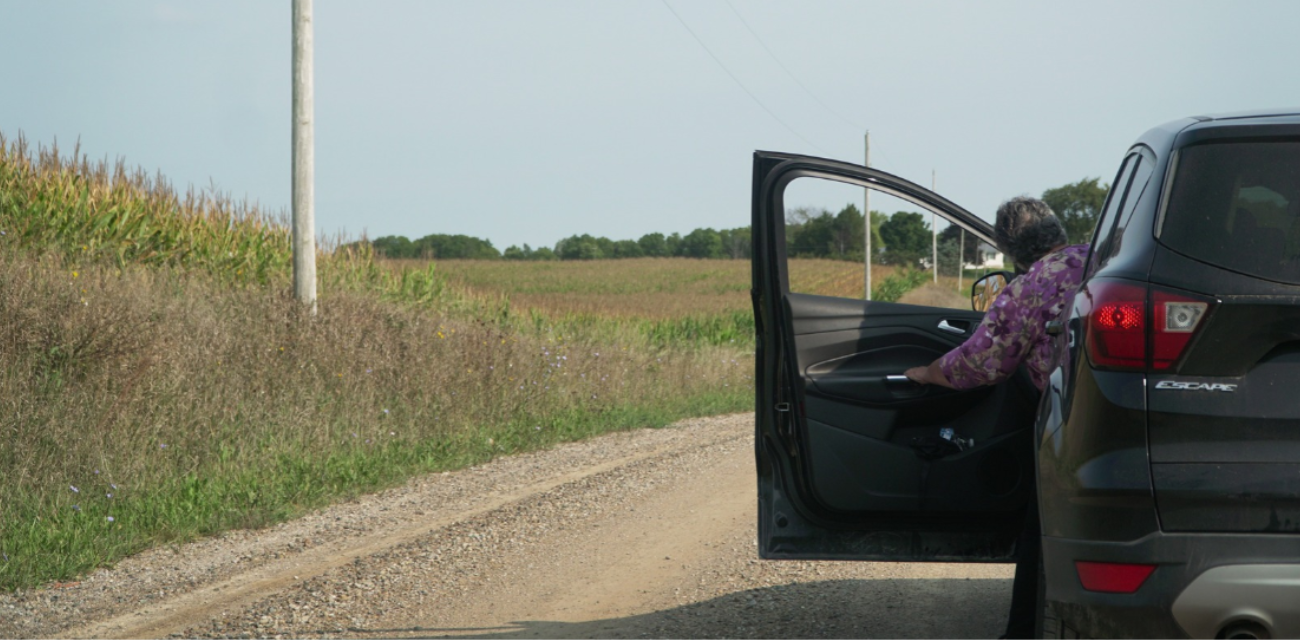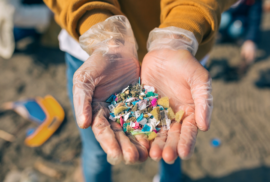Under the eyes of polluters, a farmer takes her stand

Authored by
This story is part of the Michigan Environmental Council’s 2022 member magazine, “ECOsystems: Working Wonders With Water.” You can read the magazine in full here.
We took the backroads of dirt and gravel around what seemed like the entirety of Southern Michigan, stopping periodically on the roadside but being careful not to linger too long—Pam Taylor’s black Ford Escape might be recognized by prying eyes.
Taylor’s efficient. As soon as the engine cuts, she’s out of the car, geared up in gloves and wielding a long, homemade grabber pole with a plastic water bottle duct-taped to the end. “You don’t need fancy stuff,” she said.
Taylor then begins taking a sample of a local stream in her rural home county of Lenawee, just as she has for years. Later, she’ll measure the concentration of dangerous pollutants in the water.
She does it all under the looming presence of the polluters themselves. Government documents call them combined animal feeding operations; we know them as industrial farms.
“The factory farms just in this tiny part of Michigan produce the equivalent waste to the city of Boston every day,” said Taylor. “What isn’t used by crops ends up in our waterways and contaminates our water—drinking water, surface water. This is essentially the same sewage that a city would produce.”
That means the cows and pigs crammed into the area’s industrial farms produce almost 14 times as much waste as people would. That’s 200,000,000 gallons of manure made each year. Some of it is sold and spread on crops. Some is stored in massive lagoons.

Regardless, a lot of manure seeps and trickles into our lakes, streams, and drinking water, thanks to lax laws on its storage and use. When manure hits water, it disperses up to 300 government-documented pollutants. And then it travels with the water, moving through the watershed, contaminating new H2O along the way until it reaches its end—in this case, Lake Erie.
Those manure pollutants are why beaches close, why kids and pets get sickened from swimming, and why fish populations die off. It’s also the cause of the dangerous Lake Erie algal blooms and Toledo Drinking Water Crisis of 2014.
This is why Taylor does what she does: It’s about her community, its water, and its wildlife.
STOPPING THE SKIRTING
Taylor heads up the water monitoring project of Environmentally Concerned Citizens of South Central Michigan (or ECCSCM), an Environmental Council member group internationally recognized for its work in stopping a small group of giant industrial farms from polluting en masse. This group of volunteers—some of them farmers—take photos of pollution, test water, track violations, and file reports.
Their work has been the factual, tangible foundation for state-level policy changes being pushed by ECCSCM, the Environmental Council, and other member groups like Alliance for the Great Lakes in a contested court case.

Tom Zimnicki, agriculture and restoration policy director at Alliance for the Great Lakes, said this group is going toe-to-toe with the Michigan Farm Bureau and other interest groups by fighting for an industrial farming permit’s passage. Zimnicki and Taylor want the state to better monitor how manure is being moved and to set safety measures on where and how much manure can be used.
The permit is fairly mild by their standards, but getting it passed is critical for future, bolder efforts. Throughout the legal process, Zimnicki and Taylor have hammered the need for pollution protections via ECCSCM’s decades-long watchdogging, data, and stories.
Learn more about Environmental Council membership here.

But the work does not stop there. Zimnicki said the root of all this pollution—the algal blooms, the sick kids, the fading tourism—comes down to business.
“We as a society have kind of created this monster… We as consumers have this expectation of having really cheap, really accessible food, wherever, whenever we want,” he said.
That has created a food system that has given rise to massive industrial operations which greatly overshadow small farms and farmers. And these big businesses have the power to influence policy, get tax breaks, and skirt pollution protections.
“Yes, we need better permits. Yes, we need better standards around how farms are managed,” Zimnicki said. “But we also need to change the system of agriculture.”
LOCAL, SUSTAINABLE, PERSONAL
When we drove with Taylor in her SUV, “little ghost towns,” as she called them, would occasionally pop up.
She said these used to be thriving places where farmers bought, sold, and traded. Now, the towns might just have a grocery store, a bar, a post office. The damage industrial farms have created goes far beyond water.

“I think that the key is local, sustainable—because diverse, sustainable farming on a smaller scale supports local communities,” Taylor said.
For Taylor, how we farm is personal. Her family’s lived in Lenawee since 1837. About a mile away from her century-old family home her great grandmother was born in a log cabin.
The generational hurt may take generations more to fully heal. That’s why Environmental Council member groups are fighting hard now. They aren’t letting any crap—literally—stay in our nature and communities.
ECCSCM and Alliance for the Great Lakes are just two of six member groups working with the Environmental Council to keep Michigan’s waterways clear of pollutants. To learn more or to get involved, visit environmentalcouncil.org/sustainable_agriculture. To learn more about Environmental Council membership, visit environmentalcouncil.org/members.
Article by Logan Sander and Beau Brockett
Discover
Power environmental change today.
Your gift to the Michigan Environmental Council is a powerful investment in the air we breathe, our water and the places we love.
Sign up for environmental news & stories.
"*" indicates required fields




